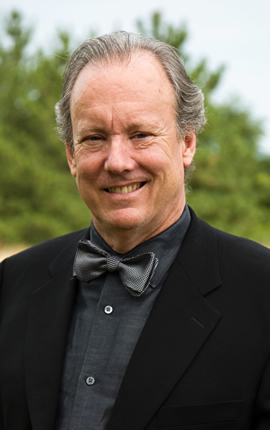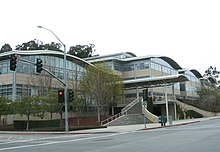 William Andrews McDonough is an American architect, founding principal of William McDonough + Partners, co-founder of McDonough Braungart Design Chemistry (MBDC) with German chemist Michael Braungart as well as co-author of 'Cradle to Cradle: Remaking the Way We Make Things also with Braungart.[1] McDonough's career is focused on designing environmentally sustainable buildings and transforming industrial manufacturing processes.
William Andrews McDonough is an American architect, founding principal of William McDonough + Partners, co-founder of McDonough Braungart Design Chemistry (MBDC) with German chemist Michael Braungart as well as co-author of 'Cradle to Cradle: Remaking the Way We Make Things also with Braungart.[1] McDonough's career is focused on designing environmentally sustainable buildings and transforming industrial manufacturing processes.
Biography
McDonough was born in Tokyo, the son of an American Seagram's executive, and trained at Dartmouth College and Yale University.[2] In 1981 McDonough founded his architectural practice,[3] and his first major commission was the 1984 Environmental Defense Fund Headquarters.[4] The EDF's requirement of good indoor air quality in the structure exposed McDonough to the need for sustainable development.[5]
McDonough's practice is located in Charlottesville, Virginia, with a small office in San Francisco, California and Amsterdam, the Netherlands.[6] McDonough moved his practice from New York City to Charlottesville in 1994, when he was appointed as the Dean of the School of Architecture at the University of Virginia.[7] He relinquished this position in 1999 to focus on expanding his professional practice.
A number of large corporate projects for The Gap, Nike, and Herman Miller,[8] which focused on both a financial and environmental standpoint, led to his commission for a twenty-year, US$2 billion environmental re-engineering of the Ford Motor Company's legendary River Rouge Plant in Dearborn, Michigan. The project included rolling out the world's largest extensive "living roof" in October 2002. The roof of the 1.1 million square foot (100,000 m²) Dearborn truck assembly plant was covered with more than 10 acres (40,000 m²) of sedum, a low-growing ground cover.[9]
In 1996 McDonough became the first and only individual recipient of the Presidential Award for Sustainable Development.[10] In 1999 Time called him "Hero for the Planet".[11] In 2002 he wrote (with Michael Braungart) Cradle to Cradle: Remaking the Way We Make Things. In 2004 he received a National Design Award for environmental design from the Smithsonian Cooper-Hewitt National Design Museum.[12]
McDonough is also a Senior Advisor and Venture Partner at VantagePoint Venture Partners,[13] one of the largest venture capital investors in clean technology.[14]
Architectural Philosophy
William McDonough and his architecture and community design firm, William McDonough + Partners, ground their work in Cradle to Cradle Design, a philosophy developed by McDonough and German chemist Dr. Michael Braungart in their 2002 book, Cradle to Cradle: Remaking the Way We Make Things. The goal is to frame design as "a beneficial, regenerative force—one that seeks to create ecological footprints to delight in, not lament."[15] This concept can be seen in the Ford Rouge Center’s green roof, which along with storm-water management benefits also creates habitat for birds.[16]

The design of the firm is often categorized as green architecture or sustainable architecture. The concept, closely linked with green building, is not known for a distinctive visual style, but for minimizing the negative environmental impact of a building. McDonough, however, is often quoted as saying the aspiration is to design something like a tree, something that creates good, like oxygen, rather than minimizing negative impact.[17] McDonough's designs use solar and other passive energy efficiency techniques, as illustrated by the William McDonough + Partners' Flow House designed for the Make It Right Foundation New Orleans. The design incorporates deep overhangs, multiple connections with exterior areas allowing for lots of daylight and natural ventilation, roof mounted PV panels, water cisterns to harvest rainwater runoff and rain gardens to absorb any storm runoff.[18]
In 1984, McDonough and his colleagues designed the Environmental Defense Fund office in New York City. Since then, William McDonough + Partners has been responsible for other milestones in the movement, such as 901 Cherry Ave in San Bruno, California, completed in 1997 for Gap, Inc.; it is now home to Google's YouTube. The building features a 70,000-square-foot green roof[19] that helps to prevent water runoff, insulates the building from noise and provides a habitat for several species, and received the BusinessWeek/Architectural Record Design Award in 1998.[20][21] The Bernheim Arboretum Visitor Center for the Bernheim Arboretum and Research Forest, in Clermont, Kentucky, completed in 2005, blurs the line between outdoor and indoor space. This project, like others designed by William McDonough + Partners, draws heavily on the biophilia hypothesis - the study of the human desire and physiological need for contact with nature. The building was awarded the U.S. Green Building Council's Leadership in Energy and Environmental Design Platinum rating.[22]
Currently under construction, the NASA Ames Research Center's Sustainability Base, is designed to be a Net Positive building—producing more energy than it needs — with potable water consumption by more than 90% when compared to an equivalent size building of conventional design, significantly reduced building maintenance costs when compared to an equivalent size building of conventional design, and an expected Platinum LEED certification.[23]
William McDonough + Partners is a core team member in the Make It Right Foundation New Orleans effort to rebuild the Lower Ninth Ward in New Orleans and the firm’s Flow House duplex design will offer its residents connections to the outdoors via access to light and views. Deep overhangs respond to the climate. Other aspects include natural ventilation, roof mounted PV panels, water cisterns to harvest rainwater runoff and rain gardens to absorb any storm runoff.[24] William McDonough + Partners was an overall adviser to the Make It Right project, bringing the Cradle to Cradle philosophy into designs by all firms involved with advising on standards by the firm.[25]
Architectural works
- Ford River Rouge Complex
- Adam Joseph Lewis Center for Environmental Studies
- 901 Cherry Office Building in San Bruno, California the current headquarters of YouTube
- Nike European Headquarters
- Bernheim Arboretum Visitor's Center located at the Bernheim Arboretum and Research Forest in Clermont, Kentucky
- NASA Sustainability Base
- Fuller Theological Seminary Library
Published works
- Braungart, Michael; & McDonough, William (2002). Cradle to Cradle: Remaking the Way We Make Things. North Point Press. ISBN 0-86547-587-3.
See also
References
- ^ "William McDonough On Cradle-To-Cradle Design". Forbes (Forbes). 2010-08-04. http://www.forbes.com/2010/08/04/steelcase-nasa-sustainability-technology-future-design-william-mcdonough.html. "William (Bill) McDonough is perhaps best known for redesigning Ford Motor's River Rouge plant with a vast green grass roof. But McDonough has morphed from pure architect to designer of everything."
- ^ Sacks, Danielle. "Green Guru Gone Wrong: William McDondough". Fast Company (Mansueto Ventures LLC). http://www.fastcompany.com/magazine/130/the-mortal-messiah.html.
- ^ "William McDonough: The 'Utopian' Architect". National Press Club (National Public Radio). 2002-04-24. http://www.npr.org/programs/npc/2002/020424.wmcdonough.html. "Founded in 1981, the team of some 40 architects practices ecologically, socially and economically "intelligent" architecture and planning in the United States and abroad."
- ^ "William McDonough: The Original Green Man". BusinessWeek (McGraw-Hill Companies Inc.). 2007-03-27. http://www.businessweek.com/innovate/content/mar2007/id20070327_813651.htm. "Virginia's dean of green architecture talks about eco-efficiency, a multi-disciplinary approach, and the need for a new platform of thought."
- ^ Shulman (2001-08-01). "Think Green". Metropolis Magazine. http://www.metropolismag.com/html/content_0801/mcd/. "But the project had a catch: the EDF told McDonough it would sue him if any of its employees took sick due to poor air quality or noxious substances in the construction. When McDonough asked his suppliers if they could provide him with a list of chemicals contained in their products, he was told it was proprietary information."
- ^ "Contact Information". William McDonough + Partners. http://www.mcdonoughpartners.com/contact. "William McDonough + Partners maintains studios in Charlottesville, Virginia; San Francisco, California; and Amsterdam, The Netherlands."
- ^ Hales, Linda (2005-08-27). "An Environmental Problem Slipping Through the Quacks". Washington Post (The Washington Post Company). http://www.washingtonpost.com/wp-dyn/content/article/2005/08/26/AR2005082601888.html. "In 1994 he moved the firm, William McDonough + Partners, to Charlottesville to become dean of architecture at the University of Virginia."
- ^ "Client List". William McDonough + Partners. http://www.mcdonoughpartners.com/projects/view/clients.
- ^ Hammonds, Don (2004-11-12). "Greener, literally: Ford's better ideas for newest plant include grass-covered roof, pollution-eating plants". Pittsburgh Post-Gazette (PG Publishing Co., Inc.). http://www.post-gazette.com/pg/04317/410625.stm.
- ^ "William McDonough: The Original Green Man". Business Week. 2007-03-27. http://www.businessweek.com/innovate/content/mar2007/id20070327_813651.htm?chan=top+news_top+news+index_innovation+%2Bamp%3B+design.
- ^ Rosenblatt, Roger (1999-02-15). "The Man Who Wants Buildings to Love Kids". Time Magazine. http://www.time.com/time/reports/environment/heroes/heroesgallery/0,2967,mcdonough,00.html.
- ^ McGregor, Jena (2006-06-12). "William McDonough: Design For Living". http://www.businessweek.com/magazine/content/06_24/b3988037.htm. "...who won the National Design Award in 2004 from the Cooper-Hewitt, National Design Museum of the Smithsonian Institution..."
- ^ "William McDonough". http://www.vpvp.com/william_mcdonough.
- ^ Hamilton, Tyler (2008-01-12). "Venture fund bets billion on cleantech". The Star (Toronto). http://www.thestar.com/Business/article/546219. "We've got the largest and deepest team focused on cleantech and well over $1 billion allocated to it"
- ^ "Design Approach". William McDonough + Partners. http://www.mcdonoughpartners.com/design_approach/philosophy.
- ^ "Buildings That Can Breathe". Newsweek. 2008-08-09. http://www.newsweek.com/id/151732.
- ^ "William McDonough on Cradle to Cradle Design". TED. 2005-02. http://www.ted.com/talks/william_mcdonough_on_cradle_to_cradle_design.html.
- ^ "William McDonough Partners Flow House In New Orleans". Inhabitat. 2009-07-13. http://www.inhabitat.com/2009/07/13/william-mcdonough-partners-flow-house-in-new-orleans/.
- ^ "Gap Office Building, 901 Cherry". Mixed Mode. 2005-02. http://www.cbe.berkeley.edu/mixedmode/gap.html.
- ^ "Space Savior". Vanity Fair. 2008-04. http://www.vanityfair.com/culture/features/2008/05/mcdonough_slideshow200805#slide=1.
- ^ "Gap Office Building, 901 Cherry". Mixed Mode. 2005-02. http://www.cbe.berkeley.edu/mixedmode/gap.html.
- ^ "Space Savior". Vanity Fair. 2008-04. http://www.vanityfair.com/culture/features/2008/05/mcdonough_slideshow200805#slide=1.
- ^ "NASA Sustainability Base". NASA. 2009-08. http://www.nasa.gov/centers/ames/greenspace/sustainability-base.html.
- ^ "William McDonough + Partners’ Flow House in New Orleans". Inhabitat. 2009-07. http://www.inhabitat.com/2009/07/13/william-mcdonough-partners-flow-house-in-new-orleans/.
- ^ "Houses of the Future". The Atlantic Monthly. 2009-11. http://www.theatlantic.com/doc/200911/curtis-architecture-new-orleans/2.
External links
- William McDonough, 2004, “21st Century Design” (accessed March 26, 2008)
- Balancing Economy, Equity, and Ecology Through Design - a speech given on Oct. 15, 2008 for Stanford's Entrepreneurship Corner, with both audio & video
- Waste = Food Documentary - A documentary on the Cradle to Cradle design concept of Michael Braungart and William McDonough.
- Fast Company: This 'Green Dean' Has a Blueprint for Sustainability
- Video of speech given at Bioneers 2000 conference
- TED Talks: William McDonough on cradle to cradle design at TED in 2005
- Speech given at the Center for Social Innovation at Stanford in Feb. 2003
- "Buildings Like Trees, Factories Like Forests", 2003 interview of McMcDonough in the Princeton Independent
- RIBA Lecture: William McDonough & Michael Braungart, 'Cradle to Cradle' 2009 (video)








